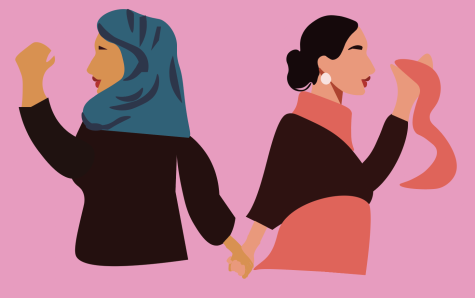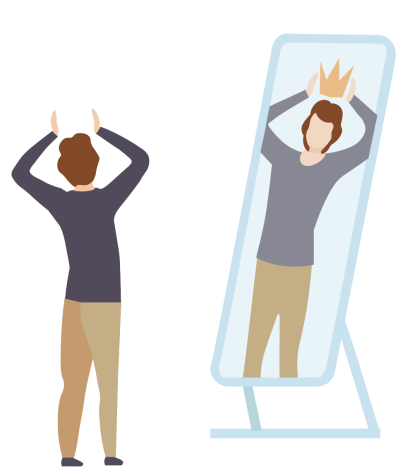Gender Neutral Pronoun Two Views
Ruben Escobar:
PRONOUNS ARE NO LONGER as simple as “he,” “she” and “they.” The more common use of gender neutral pronouns such as “zie” and “hir,” are meant to more accurately refer to those that do not identify exclusively with a binary pronoun.
Neutral pronouns offer much more flexibility in addressing people with more fluid gender identities an appropriate alternative to traditional binary pronouns. As society becomes gradually more open-minded and accepting, the use of gender neutral pronouns has begun to spread to schools, public restrooms and other areas.
According to The Humanist, “Trans[gender] people often change their names, and some do it more than once. Some identify as male or female; others identify with blended gender identities, or with entirely different gender identities other than male or female.” Some LGBTQ+ individuals do not identify with any gender, and others reject the concept altogether.
The LGBTQ+ community was right to have adopted new pronouns to properly address those who do not identify as male or female. With increasing respect for gender identity, came the formal differentiation between gender fluidity. Subsequently, more specific pronouns for new genders were created. Today, neutral pronouns are slowly becoming a cultural tradition within and outside of the LGBTQ+ community.
“I consider myself an ally of the Lesbian Gay Bisexual Transgender Queer+ (LGBTQ+) community. I identify as a straight female, but I prefer the pronoun “x”. In my opinion, anyone can have a preferred pronoun without technically being part of the community,” said sophomore Engel Murillo. “I was born and have always identified as a female, yet I prefer to be referred to as either “they” or “x” by friends, although I do not mind being called she from time to time.”
According to USA Today, a Canopy Oaks Elementary teacher in Tallahassee, Florida, sent a note home requesting that students use the following gender neutral pronouns when addressing her, “they,” “them” or more specifically “Mx.” This led to some controversy within the school district and among parents. As a result, the teacher was transferred to another program in the district.
Gender-neutral pronouns are becoming more widespread within hospitals as well. According to Healthcom Media, “people who identify across the gender spectrum may not feel comfortable being referred to with the pronouns she, her, he or him because these pronouns do not reflect their personal gender identity. New gender-neutral, non-binary pronouns include they, them, zie, zim, sie and sir.”
It is unhealthy, both mentally and physically, to not be able to express who you, as a person, are or want to be. According to the Georgetown Journal of Gender and the Law, “Medical and mental health professionals, social workers, and thousands of families recognize that when a person is not allowed to live as their authentic self, stress, anxiety, depression, and suicide are frequent consequences.”
The vocabulary expansion of nonbinary genders and pronouns has benefitted literature and spoken language by adding flexibility to speech and writing. For example, alternating pronouns in rhymes, poetry, novels or short stories is an effective way of making these works more inclusive. This new trend has spread throughout educational and healthcare sectors, and is slowly becoming normalized in society.
It is considered disrespectful to assume someone’s gender or pronoun, so, as a suggestion, it would be wise to ask beforehand. To sum, these gender neutral pronouns allow everyone to identify and be identified correctly. Without them, non-binary people would not be able to express themselves.
Alexander Sutton:
LGBTQ+ ISSUES ARE BEING discussed with increased frequency every day. The increase in attention that non-binary people have been receiving has brought pressing and controversial issues to the forefront of discussion— chief among them the great pronoun debate. Confusion arises around which pronoun should be used when somebody does not identify with either male or female, and various solutions have been proposed to resolve the uncertainty. However, not all of these solutions are created equal.
Specifically, the pronoun debate revolves around people who find the words “he” and “she” inaccurate to describe their identity, and which pronoun they should use: “they,” or newly-invented pronouns such as “zie” and “hir.” These new pronouns are relatively unknown to most people. Since the use of these new words is not mainstream, it seems for now as though the gender-nonconforming community would benefit from limiting the array of pronouns to “he,” “she,” and “they.”
With people becoming more open about gender identity, the issue demands attention. The community of people with non-binary gender identities is rich with diversity. Many designations for gender identity exist— cisgender, transgender, agender, bigender and genderqueer are just a few. It is clearer now more than ever before that there are many variations of gender perception— it has never been just male and female.
The English language is far less malleable than human gender. “He,” “she,” “it” and “they” are the four standard third-person personal pronouns used in everyday speech. One idea put forth is to repurpose the plural pronoun “they” to act as a singular, non-gender-specific pronoun instead of a plural one. People who do not identify with a single gender frequently opt to be described by the pronoun “they,” seeing it as a compromise between the male “he” and female “she.” Many scholars and grammar sticklers have balked at this idea because of its current ungrammaticality, although it has been gaining lots of traction—both the Chicago Manual of Style and the AP Style Guide have approved of its use. This solution is a good compromise, because it provides a clear and simple answer to the question of which pronoun to use if not “he” or “she.”
An alternate solution is to create new pronouns to refer to people of indeterminate gender— to make up new words, and use them as pronouns alongside the original “he,” “she” and “they.” Dozens of new pronouns have been created, “ey,” “per,” “xe,” “hir” and “zie” being among the most popular. The concept of using new pronouns has been gaining popularity since the 1980s, but has not yet become mainstream.
As an extension of freedom of speech, anybody is free to choose which pronoun they would like to use, including newly-created ones. However, choosing to call oneself by anything other than “he,” “she” or “they” seems like an unwise decision. The new neutral pronouns are not practical for everyday use, since awareness of them is still not sufficiently widespread. Using these pronouns does not provide an easy solution to the perplexing pronoun problem— it causes undue hassle to the very person who is supposed to feel more comfortable being identified by their pronoun of choice, because of the likely need to constantly explain the idea to people unfamiliar with the concept.
The 2015 U.S. Transgender Survey, conducted by the National Center for Transgender Equality, reveals that only 2 percent of the gender-nonconforming community prefers an invented pronoun, while more than a quarter of respondents designate singular “they” as the pronoun of choice.
This data proves a point: until the use of invented pronouns becomes more common, the gender-nonconforming community would benefit from limiting the array of pronouns to “he,” “she” and “they.”
Donate to CavsConnect
Your donation will support the student journalists of Coral Gables Senior High School. Your contribution will help us cover our annual website hosting costs.









